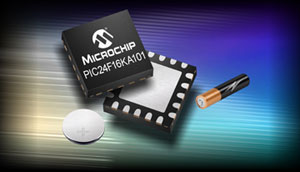Sensor Networks Look To Radio Waves for Power
February 28, 2011

Using common radio waves for power, sensor networks may soonbe able to eliminate the need for ac sources and batteries.
A newtechnology, introduced late last year, enables sensors and microcontrollers todraw small amounts of electrical current from nearby radio frequency (RF)transmitters, and then use the power to operate autonomously for years.Developers of the technology say it could offer significant advantages forhotels, hospitals, schools and office buildings, as well as for users ofwearable medical and sports devices.
"People arelooking at a range of applications, including building automation, HVAC controland small defense systems," says Harry Ostaffe, vice president of marketing andbusiness development for Powercast Corp.,maker of the new RF energy harvesting technology. "A lot of potential usershave great interest in being able to deploy sensor systems that don't need tobe maintained."
Powercast's RF technology joinsother hotnew energy harvesting power sources - including solar, thermal andvibration -- that are drawing interest from makers of electronic buildingcontrol systems and manufacturers of mobile electronic products.
Trane,for example, recently employed Powercast's Powerharvesterin a hospital HVAC system, where they used it to send power to controllers that"watch" the temperature, humidity, oxygen and CO2 levels inindividual rooms. By employing the Powerharvester, Trane engineers say theywere able to cut power consumption, reduce labor costs and eliminate the needto send technicians into hospital rooms.
"We wantedto be able to get the temperature or humidity information from a room wherethere might be three or four patients, and be less invasive and not interruptmedical procedures," says Scott Repsher, a controls project engineer for Trane."This way, we can do it without ripping down walls, running conduit or drillingholes."
Sensor Networks Look To Radio Waves for Power_B |
Trane accomplishesthat by employing Powercaster RF transmitters in the hospital hallways near therooms. The 3W transmitters broadcast RF signals at 915 MHz (a frequencycommonly used in cordless phones and baby monitors) from the hallways toantennas in the rooms. Powerharvester wireless receivers in the rooms then convertthe RF signals to dc current, storing the current in capacitors for use by awireless sensor system. The sensor system, which includes a PIC24F XLPmicrocontroller and wirelesstransceiver from Microchip TechnologyInc., uses the current from the Powerharvester to collect data from the sensors.It then sends the data out over a 2.4-GHz wireless signal to the hospital'sbuilding management system.
Powercast'ssystem enables users such as Trane to work without batteries or ac power. Forthose who are willing to use batteries, Powercast also offers a separate Powerharvesterthat enables users to store onboard energy.
Traneengineers, who are still evaluating the technology, say they like its potentialto eliminate batteries. "Batteries lead to service life issues," Repsher says."If you look at it from a service point of view, do you really want to send techsout in the field and have them change 300 batteries?"
Bright Future
Powercast engineers say that one of the keys to thetechnology's success is the availability of low-power microcontrollers andtransceivers to run the sensor applications. That's why the company teamed withMicrochip late last year to roll out a specialized developmentkit. The kit includes a wireless sensor module with low-power microcontrollerand transceiver, an RF transmitter, evaluation and development boards, and asoftware programmer/debugger.
Low-powercomponents are critical for industrial and consumer applications because theamount of electrical current available from RF transmitters is miniscule,especially as they move farther away from the application. Engineers say it'snot unusual for such energy-harvesting systems to deliver microwatts of power. Forthat reason, the two companies' development kit includes a microcontroller thatconsumes as little as 8 mu in its least power-hungry run mode, and as little as20 nA in sleep mode.
Sensor Networks Look To Radio Waves for Power_C |
Still,potential applications for the technology are multiplying fast. Powercast saysit's talking to defense contractors, server farms, energy providers, and evenstructural engineers for applications on bridges and buildings. They alsobelieve the technology could be used in medical monitoring bracelets andfitness applications.
"We cansupport applications where they use rechargeable batteries or where they don'twant to use batteries at all," Ostaffe says. "In some applications, we canpotentially eliminate the batteries by using RF."
Someexperts say that the best strategy for such applications is still to back themup with a battery. "My recommendation to anyone who's doing (energy) scavengingis to throw in a battery," says Kris Pister, chief technology officer of Dust Networks and a professor ofelectrical engineering and computer science at the University ofCalifornia-Berkeley. "That way, if you're scavenging goes away, you've stillgot the battery to give you years of lifetime. And if you've still got yourscavenging, then you're not draining the battery."
Pister saysthat some lithium thionyl chloride coin-sized cellsoffer extremely low leakage, making them strong candidates for energy-scavengingapplications. One manufacturer of the technology, Tadiran Batteries, reports that itsbatteries have self-discharge levels of less than 1 percent per year, andclaims that its batteries routinely last more than 25 years.
Withor without batteries, however, the future of energy scavenging in wirelesssensor networks is believed to be bright. "Low-power wireless sensors are goingto be everywhere," Pister says. "There's hardly an industry that wouldn'tbenefit from more sensor data. And having energy harvesting to power them makesa lot of sense."
About the Author(s)
You May Also Like






.jpg?width=300&auto=webp&quality=80&disable=upscale)

